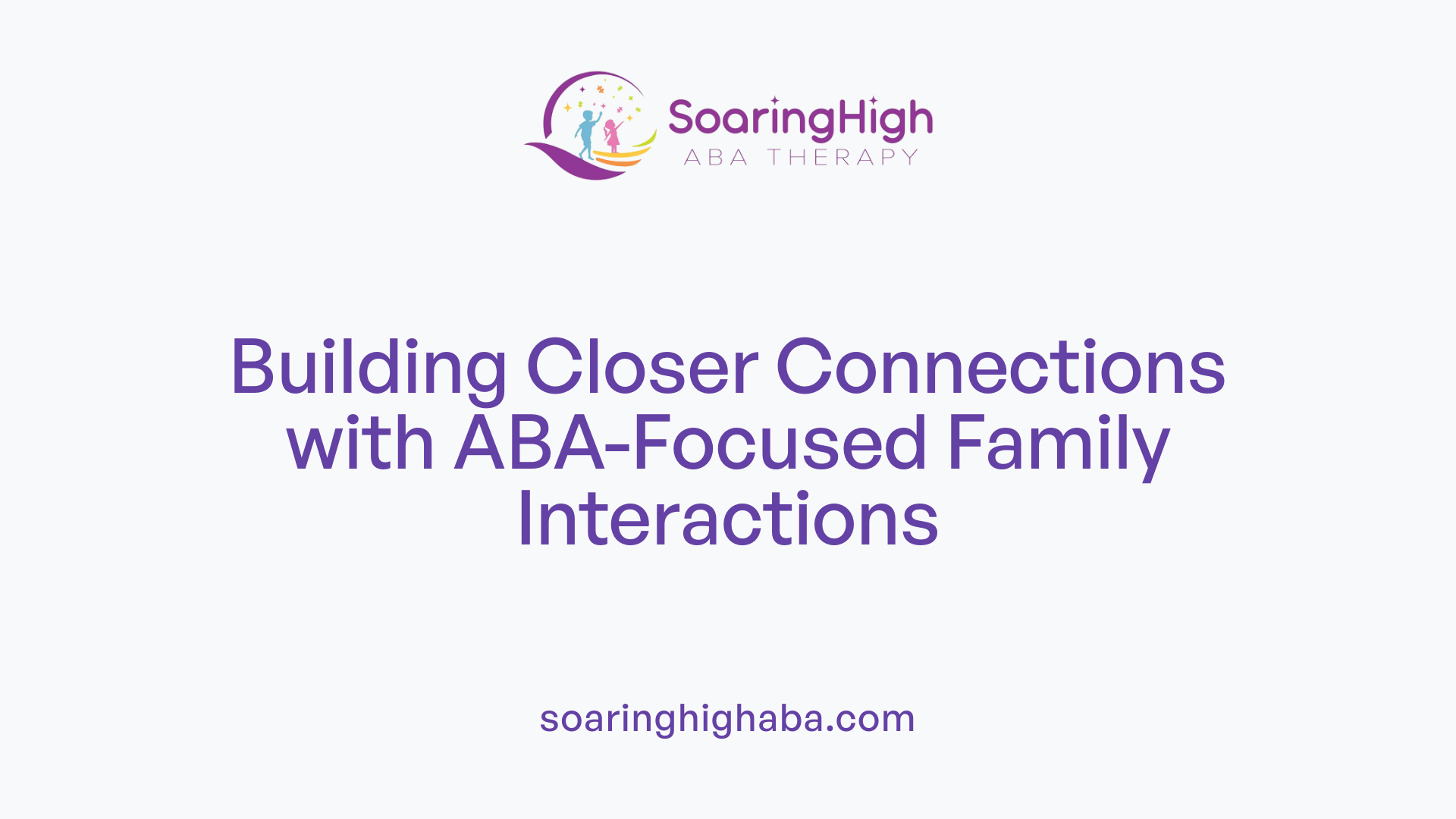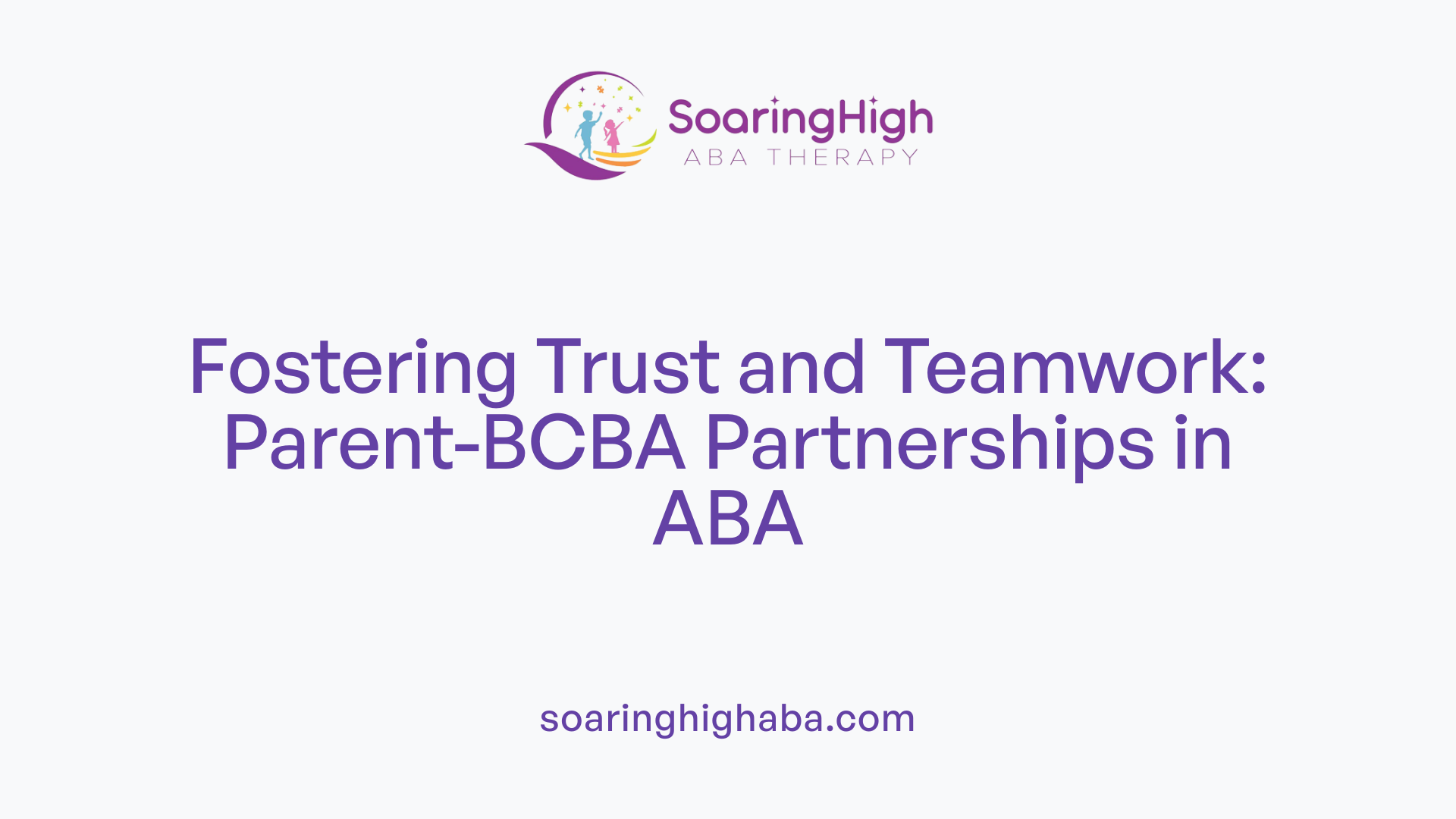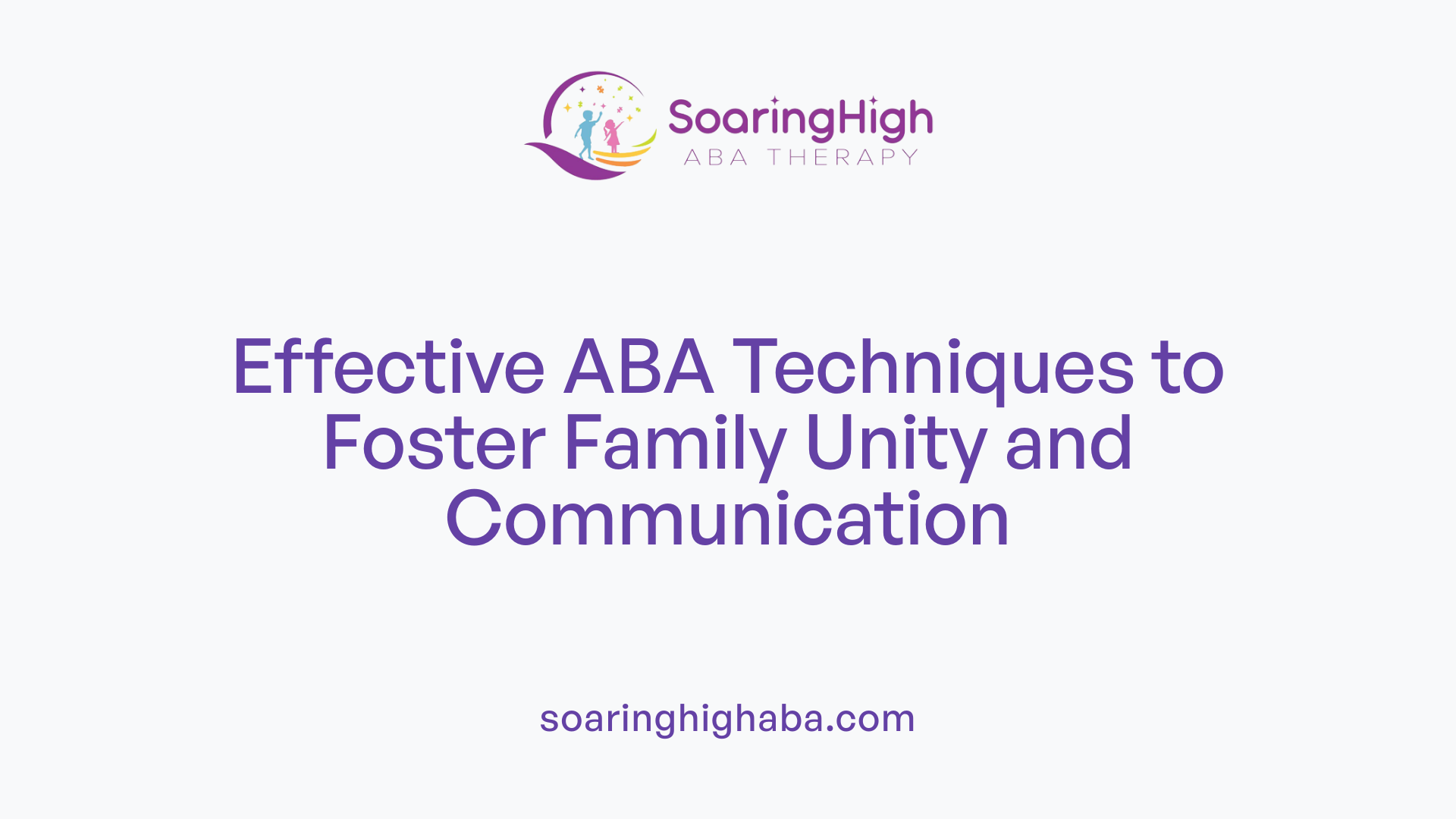Unlocking the Power of ABA in Family Dynamics
Applied Behavior Analysis (ABA) is renowned for its effectiveness in supporting children with autism, but its benefits extend beyond individual development to strengthening the entire family unit. By promoting improved communication, understanding, and collaborative strategies, ABA plays a pivotal role in building stronger, more cohesive family bonds. This article explores how ABA therapy fosters positive interactions, enhances relationships among family members, and encourages a supportive environment for everyone involved.
The Impact of ABA on Family Relationships

What role does ABA therapy play in strengthening family relationships?
ABA therapy significantly enhances family bonds by fostering open communication and positive interactions. When parents, siblings, and caregivers are actively involved in therapy, they learn strategies to better understand and support the child's needs. This involvement promotes consistency in applying techniques and helps children generalize new skills across different family settings.
Parent training is a core element, empowering caregivers with tools that manage behaviors effectively and reduce stress. As parents become more confident in implementing ABA strategies, they build greater trust and cooperation within the household.
Shared activities, such as practicing social skills or celebrating milestones, serve as opportunities for families to connect and bond. These collaborative efforts not only boost the child's development but also strengthen the emotional ties between family members.
Ultimately, ABA therapy creates a pathway for families to grow closer through teamwork, understanding, and shared successes, turning therapy goals into collective achievements and enhancing overall family harmony.
Enhancing Communication and Family Dynamics through ABA
How does ABA therapy impact family communication and dynamics?
ABA therapy plays a vital role in improving how families connect and support each other. By teaching children with autism new communication skills, ABA helps make it easier for family members to understand and respond to their needs effectively.
One of the main benefits is that ABA encourages families to work together in creating consistent routines and applying learned strategies across different settings. This collaboration results in smoother daily operations and a more predictable environment, which benefits all members, including siblings.
Family training is an essential part of the process. It empowers parents and caregivers with practical tools and knowledge to reinforce positive behaviors at home. This not only boosts parents' confidence but also creates a united front in managing behaviors.
Reducing conflicts is another significant advantage. When parents and children learn to communicate better through ABA techniques, frustrations diminish, leading to fewer arguments and misunderstandings.
Moreover, the social skills taught in ABA—for example, sharing, taking turns, and greeting others—extend beyond the child with autism. They foster empathy and patience among siblings and other family members.
Building strong emotional bonds is supported by developing better communication and shared understanding. This approach fosters patience, tolerance, and acceptance within the family, promoting a nurturing and supportive home environment.
Overall, the family-centered nature of ABA helps not just the child but the entire family build resilience, cohesion, and a hopeful outlook for the future. It creates a foundation for ongoing support, understanding, and love, strengthening family ties and fostering a positive, inclusive atmosphere.
Parent-BCBA Collaboration: Building Trust and Successful Family Bonds

Why is collaboration between parents and BCBAs important for building family bonds?
Effective collaboration between parents and Behavior Analysts (BCBAs) plays a crucial role in strengthening family relationships. When parents and BCBAs work together, they foster open lines of communication, enabling everyone involved to share insights, concerns, and progress updates. This transparency creates a trusting environment where parents feel respected and understood.
Mutual trust is essential because it encourages parents to actively participate in their child's therapy journey. BCBAs who show empathy, listen carefully, and consider family values help build this trust, making parents more comfortable in implementing strategies at home.
Personalized intervention plans are the result of close collaboration. When BCBA assessments incorporate family routines, strengths, and cultural considerations, the treatment becomes more relevant and effective. Parents learn how to reinforce positive behaviors, integrating therapy into daily life seamlessly.
Parent involvement through ongoing education and training empowers families to support their children's development outside therapy sessions. This reinforcement boosts consistency, accelerates learning, and reinforces the parent-child bond.
In summary, collaborative partnerships foster a supportive, family-centered approach. This approach not only enhances the child's progress but also improves family dynamics and emotional connections, creating a nurturing environment for everyone involved.
Strategies and Methods in ABA for Family Connection

What strategies does ABA use to foster stronger connections within families?
Applied Behavior Analysis (ABA) employs several effective strategies to strengthen family relationships and improve communication. Foremost among these is positive reinforcement, which encourages children to repeat desirable behaviors by pairing actions with rewards like praise, tokens, or preferred activities. This approach not only motivates children but also promotes a supportive and encouraging family environment.
In addition, social skills training is a core component of ABA. Children learn essential social behaviors such as sharing, taking turns, greeting others, and making eye contact. These skills are often taught through modeling, role-playing, and practice, helping children develop confidence in social settings and enhancing interactions with family members.
Structured routines are another crucial method. ABA programs introduce clear, predictable daily schedules that incorporate learned behaviors and promote stability. Implementing consistent routines helps children feel secure and reduces anxiety, fostering smoother family functioning.
By involving parents and siblings in therapy sessions and training, ABA encourages a team approach. Educating family members on techniques and strategies increases their confidence and ability to reinforce positive behaviors at home. This shared effort creates a sense of teamwork and empathy, which strengthens familial bonds.
Open communication is vital in creating understanding and reducing conflicts. When families discuss behavioral goals and share progress, it promotes transparency and mutual support. Celebrating small successes fosters motivation, making the entire family unit more cohesive.
Research by organizations like the Association for Behavior Analysis International highlights that these strategies not only help children develop social and communication skills but also promote resilience, empathy, and stronger emotional connections among family members.
| Strategy | Purpose | Typical Techniques | Family Impact |
|---|---|---|---|
| Positive reinforcement | Encourage desirable behaviors | Praise, tokens, preferred activities | Builds motivation, reduces behavioral issues |
| Social skills training | Improve interpersonal interactions | Modeling, role-playing, feedback | Enhances communication, sibling bonding |
| Structured routines | Promote stability and predictability | Visual schedules, consistent daily activities | Creates a supportive, organized environment |
Overall, these methods foster a collaborative atmosphere, enriching family bonds and improving the child's developmental journey.
Benefits of ABA Therapy in Supporting and Strengthening Families

What are the benefits of ABA therapy for supporting family members and improving relationships?
ABA therapy provides many advantages for families navigating autism. It primarily improves communication by teaching children to express their needs more clearly, using tools like visual schedules or picture cards. This leads to better understanding between children and family members, fostering closer bonds.
In addition, ABA significantly reduces family stress. By equipping parents with practical strategies to manage challenging behaviors, it creates more predictability within daily routines. Knowing how to address behaviors effectively makes parents feel more confident and less overwhelmed.
An important outcome of ABA is increased independence for children. Through targeted skill-building, children learn essential daily tasks such as brushing teeth or tying shoelaces. These accomplishments boost their self-reliance, which in turn eases the caregiving load and promotes confidence.
The collaborative aspect of ABA also enhances relationships. Parents involved in therapy sessions and family training learn techniques that promote positive interactions, reinforce routines, and establish consistent boundaries. This nurturing environment nurtures mutual understanding and cooperation.
Research supports these benefits, showing that ABA fosters better family functioning by reducing frustrations and promoting emotional connections. Such improvements not only help children develop vital skills but also strengthen the overall family unit, creating a supportive environment where every member can thrive.
Supporting Siblings and Promoting Family Cohesion with ABA

How does ABA support siblings and promote overall family cohesion?
ABA therapy plays a significant role in strengthening the family unit, especially by involving siblings directly in the therapeutic process. When siblings participate in ABA sessions or are included in routines and activities, it fosters empathy and understanding about autism. This active involvement encourages siblings to see their autistic brother or sister as a valued family member, improving their relationships and emotional bonds.
Shared routines and family training are vital components of this approach. Introducing daily activities that include all family members helps create a sense of teamwork. For example, practicing turn-taking during play or shared chores reinforces positive interactions and shared responsibilities.
Educational strategies about autism are essential for siblings to better understand their brother or sister's behaviors. Providing age-appropriate explanations tailored to their level of understanding reduces misunderstandings and minimizes frustration. When siblings comprehend the challenges and strengths of their autistic sibling, they tend to develop greater patience and compassion.
Furthermore, ABA emphasizes the importance of inclusive and structured routines. Engaging siblings in these routines—like family meals, outings, or therapy-related activities—helps build a predictable environment that benefits all family members.
Studies indicate that involving siblings in ABA-based activities not only enhances their social skills but also promotes a supportive atmosphere. For instance, teaching neurotypical siblings about positive reinforcement strategies enables them to support their sibling's learning and skill development.
Incorporating siblings in therapy and daily routines creates a collaborative family environment. It encourages open communication, empathy, and shared achievement, ultimately strengthening family cohesion.
Shared routines and activities
Creating shared routines and engaging in joint activities contribute to a more connected family life. These activities can include play sessions, community outings, or simple household chores designed to involve everyone.
Implementing specific strategies, such as celebrating individual accomplishments and fostering inclusive play, encourages siblings to participate actively. This participation not only helps children with autism generalize learned skills but also nurtures sibling bonds.
Ultimately, ABA supports siblings and promotes overall family cohesion by fostering an atmosphere of understanding, shared purpose, and mutual respect. This supportive environment benefits the entire family and enhances the child's developmental progress.
Fostering a Connected Family Environment
Incorporating ABA techniques into family life creates a nurturing environment where communication flourishes, bonds strengthen, and each member feels valued and understood. The collaborative efforts between parents, BCBAs, and children lead to a resilient and harmonious family dynamic. As families experience the tangible benefits of ABA — from improved behaviors and increased independence to deeper emotional connections — they are empowered to support each other's growth. Ultimately, ABA is a powerful tool for building lasting family bonds, turning shared challenges into opportunities for connection and collective success.
References
- The Importance of Parent-BCBA Relationships in ABA Therapy
- The Impact of ABA on Families - Prospera Healthcare
- Empowering Parents: Role of Family Training in ABA Therapy
- Benefits of ABA Therapy for Children with Autism
- Help Siblings of Children with Autism Thrive - Strive ABA Consultants
- ABA Therapy and Its Impact on Family Dynamics
- Understanding Family Autism and Applied Behavior Analysis (ABA)
- Part 9: Importance of Family Involvement in ABA Therapy





































































































